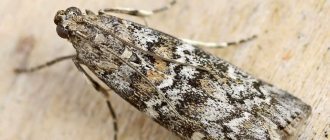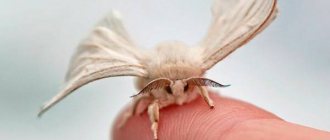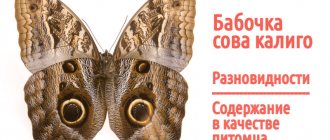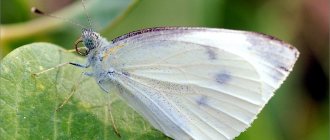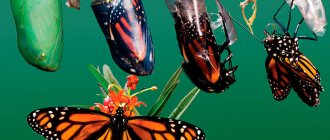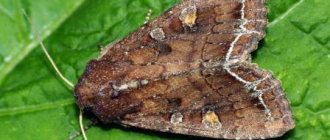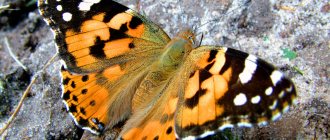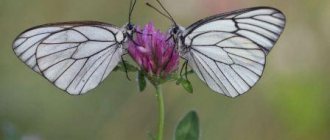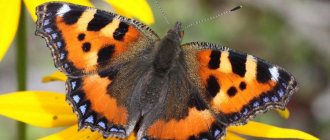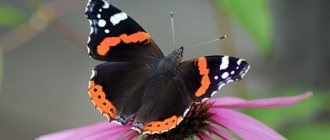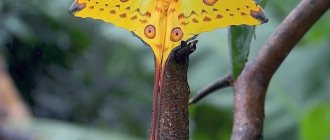Peacock-eyes - everyone has seen these butterflies. Look at the photo of the peacock eye and see for yourself! You will learn the description and types of peacock-eye butterfly, as well as many more unusual facts about peacock-eye butterflies from our article.
Peacock-eyes are a family of butterflies, which includes almost 2,300 species. These insects got their name due to their amazing resemblance to the pattern on the feathers of a peacock. On the wings of peacock eyes, their scales “painted” spots that resemble the eye-shaped pattern on a peacock’s tail.
Lesser peacock eye, or lesser night peacock eye (Saturnia pavonia).
There is no need to confuse the peacock butterfly and the peacock eye butterfly: these are completely different representatives of Lepidoptera.
Description
Peacock-eyes are a family of butterflies, which includes almost 2,300 species. These insects got their name due to their amazing resemblance to the pattern on the feathers of a peacock. On the wings of peacock eyes, their scales “painted” spots that resemble the eye-shaped pattern on a peacock’s tail.
There is no need to confuse the peacock butterfly and the peacock eye butterfly: these are completely different representatives of Lepidoptera. Depending on the species, these insects can be either very small or simply “giant” in size. For example, the small peacock eye has a wingspan of no more than 8 centimeters.
As for the large representatives of the family, which inhabit mainly tropical zones, their wings reach a span of even 27 centimeters! The average size of the wings of peacock eyes in the unfolded state ranges from 12 to 15 centimeters. In appearance, the body of the peacock eye resembles ordinary night moths: it is covered with villi that form a thick fluff. The wings have a fairly simple shape.
The color of peacock eyes is often modest, inconspicuous and even camouflage. Nature came up with this for a reason, because members of the family are nocturnal creatures. However, there are also species whose wings have bright shades or bright patterns.
Life cycle
During her short life, the female lays from 250 to 400 white-gray eggs on thin branches or leaves of food trees. The caterpillars hatch in 10-20 days. After hatching, they actively eat the leaves of various fruit trees, reaching a length of 10 cm at the end of development. The formation of the larva lasts 1.5-2 months, and its color changes with each molt. Having reached the peak of its development, the caterpillar descends into the root part of the trees, makes a pear-shaped cocoon and turns into a pupa. She spends the winter in this form. With the onset of spring warmth, hatched butterflies leave their cocoons. In case of unfavorable conditions, the pupa can overwinter again. 1 generation develops per year.
Reproduction of pear peacock eye
Saturnia pears are nocturnal moths. They fly from April to June in the evening twilight and at night. Females are less mobile: they mainly sit on branches and tree trunks. Males are more active, fly a lot, and can fly even during the day. Thanks to their long, sensitive antennae, males sense the female's pheromones over vast distances. Back in the 19th century, French entomologist Jean Henri Fabre found that a male Saturnia pear detects a female 10 km away, but if he is deprived of his antennae, this ability disappears.
An adult pear peacock eye butterfly does not feed, and the lifespan of a large night peacock eye is from 4-5 days to 2 weeks. Males live about 8 days, females - up to 20 days. After mating, female Great Night Peacocks search for a suitable location to lay eggs. They lay 250-410 eggs in a single layer in several piles or rows on thin branches or leaves of trees, which are suitable for further feeding of the caterpillars. In 24 hours, a female can lay up to 140 eggs, although by the end of her life this number is reduced to 2-3 eggs. Having laid all the eggs, the butterfly dies. The Saturnia fruit egg is white-gray in color and measures 2x2.5 mm.
Saturnia pear caterpillars hatch in 10-20 days. After hatching, they eat part of the shell of the egg in which they were located, and then actively eat the leaves of fruit trees: not only pears, but also apple trees, sloe trees, cherries, cherry plums, plums, and walnuts. Also, pear peacock eye caterpillars feed on the leaves of cherry, apricot, peach, quince, almond, currant, grape, blackthorn, olive, ash, elm, elm, linden, birch, poplar, alder, maple, plane tree and other deciduous plants. When emerging from eggs, the caterpillars are about 5-6 mm in size, but after feeding, they become very large: 9-10 cm long and as thick as an adult’s finger.
The development of the caterpillar lasts 1.5-2 months, and its color changes throughout its life:
- Animals of Siberia
- 35 facts about giraffes
- Animals of Crimea
- 36 facts about elephants
- Rodents
- 35 facts about foxes
- When hatching from an egg, the pear peacock eye caterpillar is black or dark brown in color. Four rows of warts, from which long hairs protrude, are colored light brown.
- In the second stage of development, warts become orange.
- At the third stage, the caterpillar's body acquires a green-blue tint, the warts become yellow, the head and During the fourth stage of development, as well as adult caterpillars, have a yellowish-green color and sky-blue warts, on which, in addition to hairs, spines filled with liquid appear. In addition, a long yellow stripe becomes clearly visible on the side of the body.
- Before pupation, the caterpillar of the pear saturnia acquires a golden-brown color, due to which the blue warts look even more vibrant.
By the way, adult pear peacock eye caterpillars can squeak. By rubbing their jaws, they make sounds that precede the release of a special secretion that scares away potential enemies: birds and bats.
Pear peacock eye caterpillars actively feed from May to August, and around July-August they leave the tree crown, slide down the trunk and begin to cocoon. With the help of salivary glands, the caterpillar secretes special silk threads and wraps itself in them. Typically, cocoons are located in the root part of fodder trees, as well as between stones. Some cocoons can also be found attached to tree branches. The pear peacock eye cocoon is very dense, pear-shaped, brown, 35-50 mm long. Already in the cocoon, the caterpillar turns into a pupa. She spends the winter in this form.
The great night peacock eye produces only one generation per year. If the weather is not favorable and the spring and summer are cold, the pupa can overwinter again: thus, the species maintains the population without exposing itself to danger during the breeding season. Reactivation of the pupa requires a period of 120-140 days with temperatures ranging from 8 to 16 degrees Celsius. If the spring is warm, butterflies leave their cocoons, rise to some height to spread and dry their wings, and take off.
Nutrition and lifestyle
Butterflies are very thermophilic and live in the southern regions. They fly from April to June in the evening twilight and at night. Despite its size, the insect is very short-lived, its average lifespan is from 4-5 days to 2 weeks. During this time, butterflies do not feed at all; their main goal is procreation. Females are inactive, often sitting on branches and tree trunks waiting for males, emitting pheromones to attract them. Males, on the contrary, fly a lot in search of a partner. In the dark, they can even be mistaken for a small bird or bat. In the 19th century, entomologist Jean Henri Fabre found that a male Saturnia pear can detect a female more than 10 km away. The pear peacock eye is listed in the Red Book of individual states and regions as a rare species, the number of which is insignificant.
Peacock eyes and man
Since peacock eyes are not numerous and feed on low-value tree species, they do not cause harm to humans, and the Chinese oak peacock eye has been bred in China on special plantations for 250 years. These butterflies are used in the same way as the silkworm to obtain silk threads from cocoons. The threads of the peacock eye are coarser than those of the silkworm, so they are woven not with silk, but with comb. All species of these butterflies need protection as unique creations of nature.
Where do peacock eyes live?
These arthropods inhabit the entire globe, with the exception of Antarctica. They can be found in East Asia (where they reached maximum species diversity), Europe, and America.
Pear peacock eye, or large night peacock eye (Saturnia pyri).
Peacock-eyes prefer to live in broad-leaved and mixed forests. In addition, they are found in mountainous areas and meadows, but only where there are trees nearby. “Tree dependence” in peacock-eyes is not at all accidental, because the females of these butterflies spend most of their lives in the crown of the tree, very rarely leaving their “home.”
Interesting Facts
- The Saturnia pear moth scares away birds with the help of its coloring: when an enemy approaches, it opens its wings, and the bird, seeing eyes directed at it, gets scared.
- At the beginning of the 20th century, some sources noted Saturnia pear as a minor pest of fruit crops. But the number of the butterfly declined towards the end of the century, and now the pear peacock eye does not cause harm. Although its caterpillars feed on fruit trees, due to their small numbers they cannot significantly damage them. This species of butterfly has no economic importance, unlike some other species of peacock eyes, which are silkworms. But the large night peacock eye invariably pleases people with its beauty.
- The great nocturnal peacock's eye and the great diurnal peacock's eye butterflies are not related, as the former belongs to the peacock eye family and the latter to the nymphalidae family.
- In May 1889, the famous artist Vincent Willem van Gogh, seeing an unusual butterfly in the garden of the Saint-Rémy-de-Provence clinic, was struck by its beauty and immediately made a charcoal sketch, and then a painting emerged from the sketch. The painting depicts a pear peacock eye, although the artist himself mistakenly called it “Death's Head Hawkmoth.” The museum in which it is located has renamed the painting. Now it is called “Imperial moth” (“Peacock-eye”).
- The species is listed in the Red Book of Ukraine as a “rare species” whose numbers are insignificant; only in the south of the country in favorable years is it locally common.
Video
Benefits for humans
Hercules peacock eye caterpillar (Coscinocera hercules).
The lifestyle and diet make the peacock eye absolutely harmless to agriculture, so people, as they say, do not hold any grudges against these butterflies.
Around the world, peacock eye silk threads are used along with similar silkworm material, however, peacock eye thread is believed to be much stiffer.
If you find an error, please select a piece of text and press Ctrl+Enter.
Peacock-eye atlas: appearance of a butterfly
The peacock-eye atlas (Attacus atlas) is part of the peacock-eye family, order Lepidoptera.
The Atlas peacock butterfly is one of the largest in the world. Its wingspan is about 24 cm.
The Victoria Museum, located in Australia, displays a specimen of this tropical butterfly. It was mined in 1922 on the island of Java (Indonesia). The wingspan of this butterfly is exactly 24 cm. There is an opinion that the wingspan reaches 26.2 cm, but this figure is incorrect, because it was obtained due to incorrect measurements.
The Atlas peacock butterfly got its name in honor of the ancient Greek hero Atlas (Atlas), who held the vault of heaven on his shoulders. This name emphasizes its gigantic size.
Males and females differ in the shape of their wings. Males have forewings wider than their hindwings, while females have them of the same size. Females are larger than males, and females have slightly shorter antennae.
The body of the butterfly is thick and shorter than the wings, and has a red-brown color. The color of the insect's wings is brown, red, yellow: it is darker in the center and lighter at the edges. Along the edges of the wings there are thin black and light brown stripes.
In Hong Kong, the butterfly is called the "snake-head moth" because the pattern on its wings resembles a snake's head.
The butterfly is a crepuscular species. She flies late at night and early in the morning.
Peacock eye caterpillar: description
The black caterpillar is the larva of the peacock butterfly. In appearance, it resembles a hives butterfly caterpillar. At the same time, the peacock eye caterpillar is no less interesting and beautiful than the butterfly itself. Long, needle-shaped processes of the same color grow throughout the black body. If you look closely, the entire body of the caterpillar is covered with not large, but numerous tubercles. The color of the caterpillar does not even closely resemble moths.
The caterpillar of this moth has a well-developed oral apparatus, as well as a digestive system, which provides the caterpillar with a continuous process of processing food. Thanks to this fact, the caterpillar grows and develops quite quickly.
It is born with very small dimensions (only 1 mm). The development period is about 6 weeks. During this period of development, the caterpillar molts up to 4 times. Its chitinous cover is very durable, and its black color does not allow one to see the food inside the caterpillar, which cannot be said about other types of caterpillars. The caterpillar's body is armed with legs, which allows it to move along the stems and leaves of plants.
In the photo below you can see what a peacock eye caterpillar looks like.
Reproduction process
The female butterfly overwinters in various shelters. These could be cracks in wooden buildings, forest floor, just piles of garbage, etc. When spring comes and favorable conditions are created, the female leaves her shelter and lays about 300 eggs of a light green hue. She forms colonies of them on the underside of nettle leaves.
The first breeding stage begins in mid-spring and ends in May. If weather conditions permit, the subsequent breeding stage begins in mid-summer and ends in August. Around mid-autumn, butterflies emerge from the caterpillars, after which the butterflies look for places to spend the winter. An adult female, after laying eggs, lives no more than 3 weeks, and males even less.
Interesting fact! Females and males do not lead the same way of life. If the female peacock eye is mainly nocturnal, the males, on the contrary, fly more during the day.
Larval development process
Somewhere, after 4 weeks, if conditions are favorable, the peacock butterfly caterpillar completes the next stage of development. As a rule, the butterfly lays eggs on nettle leaves, so the emerging larvae feed on the greenery of this particular plant. They are found on plants in groups, and they occupy the entire plant. This caterpillar is also found on other plants. For example:
- On the willow.
- On raspberries.
- On ordinary hops.
- On hemp.
After 4 weeks, the caterpillars turn into pupae. The caterpillars remain at the pupal stage for up to 2 weeks. The color of the pupae depends on which part of the plant the pupae are attached to.
During the pupa stage, unique processes take place inside the pupa, as a result of which one of the most beautiful butterflies on the planet emerges from an unpleasant caterpillar.
Caterpillar sabotage
At no stage of its development is this insect capable of causing serious harm, especially to cultivated plants, since it prefers to settle on burdocks, thistles, thyme, scabioses, etc. Butterflies can often be seen on garden and ornamental plants, where they perform pollination.
The main source of food for the caterpillars is nettle, which is simply abundant everywhere. The only cultivated plant that can suffer from caterpillar infestation is raspberries.
On a note! Despite its significant numbers, this butterfly is protected and listed in the Red Book.
Black caterpillar of the Peacock butterfly, Larva of European peacock

